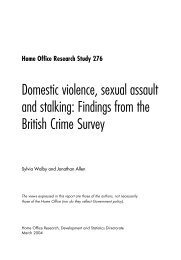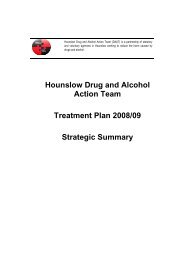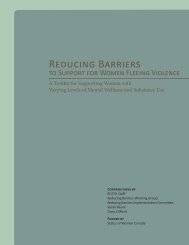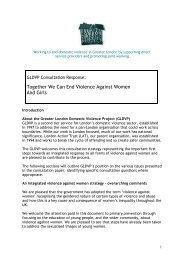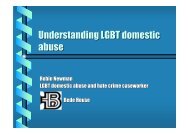1 Domestic violence information
Theory and Practice for the Substance Misuse Sector (pdf - AVA
Theory and Practice for the Substance Misuse Sector (pdf - AVA
You also want an ePaper? Increase the reach of your titles
YUMPU automatically turns print PDFs into web optimized ePapers that Google loves.
2.3 Key pieces of legislation<br />
<strong>Domestic</strong> Violence Crime and Victims Act (2004)<br />
• Section 1: amends the Family Law Act 1996 to make breach of a<br />
non-molestation order a criminal offence, punishable by up to five<br />
years of imprisonment<br />
• Section 3: definition of ‘cohabitants’ to include same sex couples<br />
and extends provisions to include non-cohabiting couples [not<br />
enacted – but enacted under the Civil Partnerships Act (2005)]<br />
• Section 4: makes couples who have never cohabited or been<br />
married eligible for non-molestation and occupation orders, under<br />
the Family Law Act 1996<br />
• Section 5: creates a new offence of causing or allowing the death of<br />
a child or vulnerable adult. This establishes criminal responsibility for<br />
members of a household where they know a child or vulnerable adult<br />
is at significant risk of serious harm<br />
• Section 9: establishes domestic <strong>violence</strong> murder reviews [not enacted]<br />
• Section 10: common assault is an arrestable offence [not enacted –<br />
but common assault is arrestable under the Serious Organised<br />
Crime and Police Act (2005)]<br />
• Section 11: allows a court to make a restraining order when the<br />
defendant has been acquitted of the offence<br />
• Section 12: will enable courts to impose a restraining order when<br />
sentencing for any offence, on conviction and also on acquittal<br />
Sexual Offences Act 2003<br />
Overhaul of the previous law on sexual offences. There is now a:<br />
• New definition of rape which now includes oral penetration<br />
• New offence of sexual assault. This replaces indecent assault<br />
• New offences of assault by penetration and causing a person to<br />
engage in sexual activity<br />
• New definition of consent. The onus is now on the perpetrator to<br />
show that he took steps to find out that the victim was consenting<br />
Protection from Harassment Act (1997)<br />
This can be used to stop an abuser from behaving in ways that<br />
aren’t actually criminal offences (e.g. uninvited visits) yet which are<br />
still distressing and intimidating. To use this, there needs to have been<br />
two or more incidents and survivors need to inform the police of the<br />
perpetrator’s harassing behaviour and the police will need to issue<br />
them with a formal caution. 14<br />
If they continue to harass the survivor after this, the perpetrator can<br />
be arrested and could face up to five years in prison. Unusually, the<br />
Act contains both civil and criminal remedies for those experiencing<br />
harassment from another person and created two new offences of<br />
causing harassment and causing fear of <strong>violence</strong>. The criminal court<br />
can make a restraining order on conviction.<br />
Children Act (1989) (2004) and the Adoption & Children Act (2002)<br />
See pg 196-198.<br />
Rights of Women www.rightsofwomen.org.uk can give more advice<br />
and <strong>information</strong> about the civil and criminal law and can be contacted<br />
on 020 7251 6577. The website also gives more in depth <strong>information</strong><br />
regarding the law and details of training courses on domestic <strong>violence</strong><br />
and the law.<br />
112<br />
© Stella Project Section 3 - <strong>Domestic</strong> Violence<br />
© Stella Project Section 3 - <strong>Domestic</strong> Violence 113



